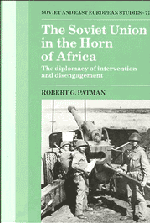Book contents
- Frontmatter
- Contents
- List of maps
- List of tables
- Preface
- List of abbreviations
- Note on transliteration of Russian words
- INTRODUCTION
- PART I MOTIVATIONAL ASPECTS
- PART II THE HORN OF OPPORTUNITY
- 4 The budding alliance: Marx, Lenin and Mohammed
- 5 The Ethiopian revolution and the quest for a Pax Sovietica
- 6 War, realignment and the enforcement of proletarian internationalism
- CONCLUSION
- Appendix A Soviet–Somali treaty of 11 July 1974
- Appendix B Soviet–Ethiopian treaty of 20 November 1978
- Notes
- Bibliography
- Index
- Soviet and East European Studies
4 - The budding alliance: Marx, Lenin and Mohammed
Published online by Cambridge University Press: 29 January 2010
- Frontmatter
- Contents
- List of maps
- List of tables
- Preface
- List of abbreviations
- Note on transliteration of Russian words
- INTRODUCTION
- PART I MOTIVATIONAL ASPECTS
- PART II THE HORN OF OPPORTUNITY
- 4 The budding alliance: Marx, Lenin and Mohammed
- 5 The Ethiopian revolution and the quest for a Pax Sovietica
- 6 War, realignment and the enforcement of proletarian internationalism
- CONCLUSION
- Appendix A Soviet–Somali treaty of 11 July 1974
- Appendix B Soviet–Ethiopian treaty of 20 November 1978
- Notes
- Bibliography
- Index
- Soviet and East European Studies
Summary
Although the Soviet Union and Somalia lie on different continents thousands of kilometres apart there is much in common that brings the two countries together and makes them comrades-in-arms and friends. They are at one in the struggle against imperialism and colonialism and have been acting unitedly in the struggle for lasting world peace.
(V. Sofinsky, ‘Somalia on the Path of Progress’, International Affairs (Moscow), no. 11, November 1974, p. 65).Between 1971 and 1974, the initial enthusiasm of the USSR for the Somali revolution was converted into a major commitment. Moscow, in the words of President Siad, became ‘Somalia's greatest helper’. In the economic sphere, Soviet technical and financial assistance covered more than twenty projects in the country. Altogether, Soviet economic assistance was valued at $100 million. This figure, when compared with that made available to other African states was, by Soviet standards, substantial. However, in the military field, the Soviet contribution was even more impressive. Estimates vary but even the most conservative suggest a ten-fold increase of Soviet military aid to Somalia during this period. By 1974, the Somali military inventory reportedly included large numbers of MiG fighter planes, T-54 tanks and a vast assortment of heavy arms. In return, the USSR obtained a major naval facility at Berbera and access to a number of Somali airfields. As a result of these arrangements, about 3,600 Soviet advisers, of whom roughly 1,400 were military personnel, had flocked into Somalia by 1974. Then, on 11 July 1974, the Soviet–Somali relationship reached a ‘qualitatively new and higher stage’ with the signing of a Treaty of Friendship and Co-operation.
- Type
- Chapter
- Information
- The Soviet Union in the Horn of AfricaThe Diplomacy of Intervention and Disengagement, pp. 113 - 149Publisher: Cambridge University PressPrint publication year: 1990



